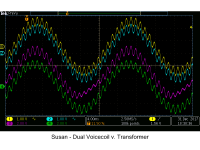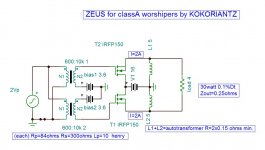As requested a seperate thread on transformer based solid state amplifers. <snip>
I am looking for the amp in exact this kind, but with an outdoor power supply, which is standing far away from the actually power amplifier.
Is such a set up available anywhere ?
Why would you?
This amplifier has excellent PSRR.
Susan's build is perfect; no need to build two chassis with maybe worse results.
This amplifier has excellent PSRR.
Susan's build is perfect; no need to build two chassis with maybe worse results.
I built this amplifier in both versions with 6c33c tube SE driver and mosfet SE driver.
In general the sound is natural and "liquid" with very good details. The sound stage is very stable and accurate even when playing complex tracks. I think it's very fast and it controls the loudspeaker very well thanks to the output transformer. It's easy to get addicted to its sound. I compared it to a few other common amplifiers and I have to say they are all far away from Zeus. Listen to this amplifier for a while then if you listen to other amplifiers you will understand their problems.
I prefer the 6c33c tube driver as it gives more crispy sound but not harsh. I feel the mosfet driver a little too soft.
In general the sound is natural and "liquid" with very good details. The sound stage is very stable and accurate even when playing complex tracks. I think it's very fast and it controls the loudspeaker very well thanks to the output transformer. It's easy to get addicted to its sound. I compared it to a few other common amplifiers and I have to say they are all far away from Zeus. Listen to this amplifier for a while then if you listen to other amplifiers you will understand their problems.
I prefer the 6c33c tube driver as it gives more crispy sound but not harsh. I feel the mosfet driver a little too soft.
Hi, I built the single ended (gapped) EI and the output PP EI transformer following Susan's design but I designed and built the little input (or interstage or passive amplifier) transformer. I only used toroidal transformers in the power supply. Driver and power have dedicated PSU. And mono block design.
Would there be any issues with building this amp to use power JFETs? I'm curious if anyone has tried.
Maybe the reason therefore is the too high output impedance of the driver stage from your used pre-amplifier.I feel the mosfet driver a little too soft.
Hi Apelizzo!
Could you tell me more detail about your input transformer?
Greets:
Tyimo
I designed and built the little input (or interstage or passive amplifier) transformer
Could you tell me more detail about your input transformer?
Greets:
Tyimo
OK, I'll bite. Can you explain what you really mean (and which bipolars you'd use)?I would use bipolars. Little ones;-) To less the "soft"-ness.
Right now it sounds like you're proposing using less linear devices, with the result that you increase the level of 3rd, 5th and 7th harmonics. Plus most bipolars I know have gain that varies with Icb.
"increase the level of 3rd, 5th and 7th harmonics": not relevant.
"gain that varies with Icb": not relevant.
To get some parts-experiences (and listening/audible-measurement-experiences, compared with looking-measurement-experiences;-) I would replace the TO-247 MosFets with "similar" TO-220 MosFets first.
Later I would replace the TO-220 MosFets by any TO-220 bipolars.
LG
"gain that varies with Icb": not relevant.
To get some parts-experiences (and listening/audible-measurement-experiences, compared with looking-measurement-experiences;-) I would replace the TO-247 MosFets with "similar" TO-220 MosFets first.
Later I would replace the TO-220 MosFets by any TO-220 bipolars.
LG
Direct Drive using a Dual Voice Coil Loudspeaker
Hi,
Best 2018 New Year seasons greetings.
In answer to your question:
Basically it doesn't work because the speaker voice coil inductances are too small and so don't couple or store enough energy to work outside the narrow watt or so of PP Class A operation from the biasing.
Attached is a scope grab showing Direct Drive and Transformer 1:1 Drive for comparison, as can be clearly seen (and heard) the 1KHz tone gets crunched by the LF one.
At low levels it sounds really great... 🙂
Best,
Susan.
Hi,
Best 2018 New Year seasons greetings.
In answer to your question:
Post # 1 of this thread shows T1 power output transformer. The attached schematic suggests using a dual voice coil woofer instead of T1. Maybe this approach is already buried in one of the 1600 posts!
Basically it doesn't work because the speaker voice coil inductances are too small and so don't couple or store enough energy to work outside the narrow watt or so of PP Class A operation from the biasing.
Attached is a scope grab showing Direct Drive and Transformer 1:1 Drive for comparison, as can be clearly seen (and heard) the 1KHz tone gets crunched by the LF one.
At low levels it sounds really great... 🙂
Best,
Susan.
Attachments
I'm still trying to understand what you mean by "To less the "soft"-ness."
Can you suggest particular types of music (or even better, specific passages in specic recordings) where the effect you are describing can be clearly heard? What change are we supposed to be hearing?
(and listening/audible-measurement-experiences, compared with looking-measurement-experiences;-)
Can you suggest particular types of music (or even better, specific passages in specic recordings) where the effect you are describing can be clearly heard? What change are we supposed to be hearing?
"To get some parts-experiences (and listening/audible-measurement-experiences, compared with looking-measurement-experiences;-) I would replace the TO-247 MosFets with "similar" TO-220 MosFets first.
Later I would replace the TO-220 MosFets by any TO-220 bipolars."
The methods to study will follow;-)
Later I would replace the TO-220 MosFets by any TO-220 bipolars."
The methods to study will follow;-)
Attachments
10k:600 is some 4:1 voltage (winding) ratio.
Reading the description, I'd have my doubts:
Quote:
Permalloy 10K:600 audio step-downIsolation transformer: mark the measured value on the transformer.High quality audio step-up transformer, imported permalloy material, can be filtered to eliminate AC noise interference,Digital killer. For a variety of high-end professionalsHIFI front stage, audio signal boost use.
It can also be used upside down,Impedance 600:10K.
The measured voltage ratio is1 to 0.6.That is to say, 10K The input voltage is 1V, and the output voltage of the 600Ω winding is 0.6V,The signal is attenuated.
But, regarding price, you can take the chance.
Reading the description, I'd have my doubts:
Quote:
Permalloy 10K:600 audio step-downIsolation transformer: mark the measured value on the transformer.High quality audio step-up transformer, imported permalloy material, can be filtered to eliminate AC noise interference,Digital killer. For a variety of high-end professionalsHIFI front stage, audio signal boost use.
It can also be used upside down,Impedance 600:10K.
The measured voltage ratio is1 to 0.6.That is to say, 10K The input voltage is 1V, and the output voltage of the 600Ω winding is 0.6V,The signal is attenuated.
But, regarding price, you can take the chance.
A friend of me want to build this amp. The question is, where he can order the output and input transformer.
Thank you very much for advices.
Thank you very much for advices.
Hi,
Best 2018 New Year seasons greetings.
Hello,
Thank you for your results and the well wishes for 2018. I hope that you also have a safe, healthy and prosperous 2018.
All the best
Anton
- Home
- Amplifiers
- Solid State
- Zero Feedback Impedance Amplifiers

